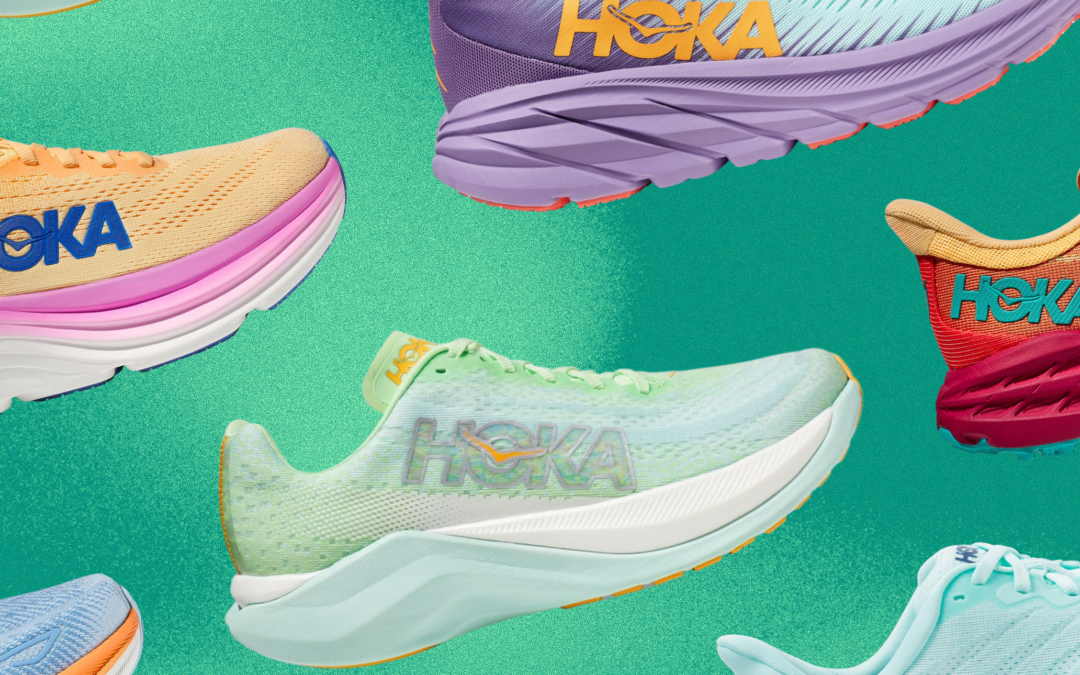If you’re seriously ready to replace your old running shoes and you haven’t given Hokas a try yet, let this be your sign. With all the hype around their style (Bright colors! Pillowy soles!), it’s easy to overlook that Hoka sneakers are designed for runners first. And, as the brand’s range of options continues to expand, there’s likely a pair that suits your personal preferences.
What should you look for in a running shoe?
According to SELF’s sneaker buying guide, a good running shoe will accommodate your foot’s length, width, and overall shape, including the arch. There needs to be room to wiggle your toes, your heels should be secure (like they’re not going to slip out), and your arch should feel cradled (not like it’s collapsing or lifting above its natural height).
Beyond a shoe’s fit, you can also look for features like cushioning, durability, flexibility, and responsiveness. A beginner-friendly shoe will have a good blend of those elements, Nicola S. Corbett, MD, board-certified orthopedic surgeon and foot and ankle specialist at Connecticut Orthopaedics, tells SELF. That combination will give you a solid foundation for your runs, and as you gain experience, you may develop more specific preferences depending on your goals.
If speed is your priority, look for more responsive shoes with a springy midfoot or rocker bottom (a.k.a. curved sole), says Dr. Corbett. She explains that these designs will help propel you forward, and prevent your feet from landing flat. A lighter-weight shoe will also help you conserve some energy—heavier shoes require you to spend more effort lifting your feet and moving them through the air, which can make your run feel harder, as SELF reported previously.
On the other hand, if you mainly want to stay comfy on everyday runs, look for shoes with plenty of cushioning and shock absorption, says Dr. Corbett. You may sacrifice a bit of speed—extra padding adds to the shoe’s weight—but many high-quality sneakers strike a balance between comfort and spring.
Finally, consider your shoe’s outsole: Do you need it to grip damp pavement or keep your footing sure over rocky paths? If so, Dr. Corbett recommends looking for shoes with extra traction. Or, if you’re taking them on the trail, she says to choose a pair with a deep tread (which will help the shoe bite into the ground and keep your steps steady).
If possible, it’s always a good idea to try running shoes on in person so you can get a real feel for them—but if you’re set on buying online, consider shopping at retailers that have reliable return policies so you can test a few pairs before committing.
What are Hoka running shoes best for?
In previous years of SELF Sneaker Awards, Hoka’s shoes have earned top marks from testers for their cloudlike cushioning and ability to make even the dullest runs more enjoyable. The most popular pairs are easy to spot, with their chunky, outsize soles—and they’re probably best suited for runners who want a super plush ride.
However, there are other Hokas that only have a moderate amount of padding, and additional highlights like sturdier support or a lighter-weight feel. So although Hoka is an obvious pick for fans of maximalist shoes, it has a lot to offer other types of runners too. As podiatrists have previously told SELF, the brand’s sneakers are also a great choice if you have plantar fasciitis (a common source of stabbing heel pain) or flat feet.
The best Hoka running shoes
Ready to see what all the Hoka hype is about? We’ve selected the best options, according to the aforementioned expert criteria as well as feedback from SELF Sneaker Award testers and staffers.
All products featured on SELF are independently selected by our editors. However, when you buy something through our retail links, we may earn an affiliate commission.

